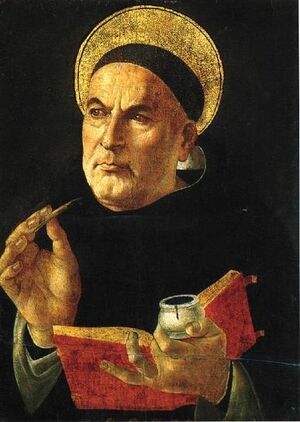Course:Law3020/2014WT1/Group X/Natural Law
Thomas Aquinas: Natural Law Theory
Introduction
E.B. v. Order of the Oblates of Mary Immaculate considers the vicarious liability of a lay employee of a residential school, as it was found he was sexually assaulting a student. When vicarious liability is used, the superior can be found liable for the acts of a subordinate yet primary actor if the risk to the victim was created or intensified by the employer. To examine the doctrine of vicarious liability under the lens of Natural law, we consider the four elements of a valid law as identified by Thomas Aquinas.
Elements of a Valid Law
- A law must be directed to serving the common good of the people.
- The doctrine of vicarious liability is directed at the common good of the people in the sense that it is holding the party that can personally compensate for a harm, liable.
- This prevents the victim from failing to be compensated as a result of the personal bankruptcy of the main actor and loss is properly redistributed.
- However, this raises the question of why it is not only the person directly responsible for the harm that is held liable. The person who did the harm is ultimately responsible.
- Natural law must follow practical reason, by taking steps to achieve the common good.
- In this way, an employee should be held responsible for the conduct of employees.
- Another requirement of a valid law under natural law is that it must be from a valid lawmaker.
- Aquinas wouldn’t necessary see common law doctrines as properly valid. However, today, common law is widely accepted as valid.
- The promulgation of a proper law requires that it cannot be a secret from the people it applies to.
- Common law is not static and unchanging. But it is visible for people to read and be aware of, with the help of lawyers to interpret.
The Bazley Test
The Supreme Court uses the test from Bazley v Curry, which sets out the requirements for a finding of vicarious liability. The two factors of the Bazley Test include:
- Acts authorized by the employer or
- Acts which are not authorized by the employer, but are so connected to authorized acts that they may be considered "modes" of acts authorized by the employer.
To examine the validity of this law under the scope of human law, we start with the capacity for this doctrine to serve the common good. The goal of this test is to provide a just and practical remedy for victims, and to deter future harm. The practical reason of the Bazley test involves the court’s considerations of how vicarious liability can be found or limited. The court looks to policies to serve society effectively, but still prevent potential floodgates from opening.
The valid lawmaker in the Bazley test is the Supreme Court of Canada, which is the highest common law authority we may consider.
This test is promulgated through the dissemination of common law judgments.
Application
To consider the validity of the majority judgment in E.B. v. Order of the Oblates, we examine the relation to the common good. The court placed a limit on the Bazley test, refusing to implement it in too broad a sense. It was held that vicarious liability can only be found if martin Saxey’s regular responsibilities in his employment involved close contact with children. Since this wasn’t the case, and he was acting outside of the scope of his assigned duties, vicarious liability could not be found by the Court.
In considering the practical reasoning in the majority, Aquinas would likely say that such a wrongful act needs to be punished, and the victim given retribution. Aquinas would likely support direct liability for the reason that the Order of the Oblates were not the main party responsible.There is a strong belief in punishing the person who has committed a wrongful act, and not punishing anyone who did not cause any harm. For this reason, the court's decision to not extend vicarious liability would be supported by Thomas Aquinas, as would be the court's note that if the direct liability of Martin Saxey was brought up as an issue, there would be no trouble in finding him liable for his conduct towards the plaintiff.
The majority is a valid lawmaker in this case because of their authority as appointed judges by a wise few, which would have been approved by Aquinas. Judges are given significant discretionary powers, and the judges of the Supreme Court are chosen for their intelligence and skill in wielding the law in order to arrive at decisions that are just, fair, and consistent with the principles of justice.
Thomas Aquinas would also agree that the court's holding is validly promulgated because it is written and publicized as a Supreme Court judgment, and is available to all to study.
While Thomas Aquinas would disagree with the findings of the majority, Abella J., in her dissent focusses more on the common good which is such a high priority in Aquinas' conception of law. The common good in the dissent is served by holding an employer accountable for the conduct of employees. By hiring a dangerous person like Martin Saxey, the risk to the yound students under the care of the Oblates was increased, and so liability should be found. Harmful acts need to be punished, even if this is accomplished through vicarious liability. If Aquinas were to read the dissenting judgement, he would agree that the Order of the Oblates caused harm to come to the plaintiff, and so as a result they should be held responsible for that harm.
